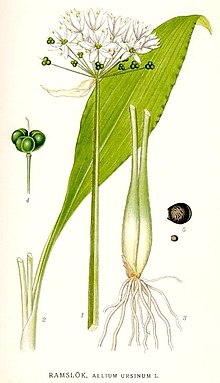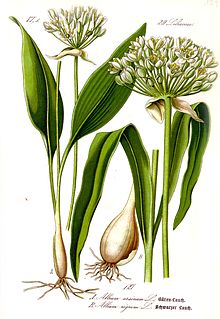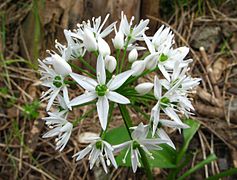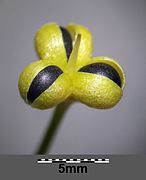Allium ursinum
| Allium ursinum | |
|---|---|

| |
| Scientific classification | |
| Kingdom: | Plantae |
| Clade: | Tracheophytes |
| Clade: | Angiosperms |
| Clade: | Monocots |
| Order: | Asparagales |
| Family: | Amaryllidaceae |
| Subfamily: | Allioideae |
| Genus: | Allium |
| Subgenus: | A.subg.Amerallium |
| Species: | A. ursinum
|
| Binomial name | |
| Allium ursinum | |
| Synonyms[1] | |
|
Species synonymy
| |

Allium ursinum,known aswild garlic,ramsons,cowleekes,cows's leek,cowleek,buckrams,broad-leaved garlic,wood garlic,bear leek,Eurasian wild garlicorbear's garlic,is abulbousperennialflowering plantin the amaryllis familyAmaryllidaceae.It is native to Europe and Asia, where it grows in moist woodland.[2]It is a wild relative ofonionandgarlic,all belonging to the same genus,Allium.There are two recognized subspecies:A. ursinumsubsp.ursinumandA. ursinumsubsp.ucrainicum.[3]
Etymology[edit]
The Latin specific nameursinumtranslates to 'bear' and refers to the supposed fondness of thebrown bearfor the bulbs; folk tales describe the bears consuming them after awakening from hibernation.[3]Another theory is that the "ursinum"may refer toUrsa Major,asA. ursinumwas perhaps one of the most northerly distributedAlliumspecies known to theancient Greeks,[3]though this hypothesis is disputed.[4]Common names for the plant in many languages also make reference to bears.[5]
Cows love to eat them, hence the modern vernacular name of cows's leek.[6]In Devon, dairy farmers have occasionally had the milk of their herds rejected because of the garlic flavour imparted to it by the cows having grazed upon the plant.[6]
Ramsons is from the Saxon wordhramsa,meaning "garlic". There is evidence it has been used in English cuisine sinceCeltic Britonsover 1,500 years ago.[7]
Early healers among the Celts, Gaels, Teutonic tribes and ancient Romans were familiar with the wild herb and called itherba salutaris,meaning 'healing herb'.[7]
Description[edit]

Allium ursinumis a bulbous, perennial herbaceousmonocot,that reproduces primarily by seed. The narrow bulbs are formed from a single leaf base[8]and produce bright green entire, elliptical leaves up to 25 cm (9.8 in) long x 7 cm (2.8 in) wide with a petiole up to 20 cm (7.9 in) long.[8]Theinflorescenceis anumbelof six to 20 white flowers, lacking thebulbilsproduced by some otherAlliumspecies such asAllium vineale(crow garlic) andAllium oleraceum(field garlic).[9][8]: 394 [10]: 902 The flowers are star-like with six whitetepals,about 16–20 mm (0.63–0.79 in) in diameter, with stamens shorter than the perianth.[8]
It flowers in the British Isles from April to June,[8]: 394 starting before deciduous trees leaf in the spring. Theflower stemis triangular in cross-section and the leaves are broadly lanceolate, similar to those of the toxic lily of the valley (Convallaria majalis).[3]
Distribution[edit]
It is native to temperate regions of Europe, from Ireland east to theCaucasus.[citation needed]It is common in much of the lowlands of the British Isles with the exception of the far north of Scotland,OrkneyandShetland.[11]Theursinumsubspecies is found in western and central Europe, while theucrainicumsubspecies is found in the east and southeast.[3]
Herbal remedy[edit]
Allium ursinumhas been credited with many medicinal qualities and is a popular homeopathic ingredient. It is often used for treating cardiovascular, respiratory, and digestive problems, as well as for the sterilisation of wounds.[12]
Various minerals are found in much higher amounts inAllium ursinumthan in clove garlic. It is sometimes called the "magnesium king" of plants because of the high levels of this mineral found in the leaves.[citation needed]
Habitat[edit]

It grows indeciduouswoodlands with moist soils, preferring slightly acidic conditions. In the British Isles, colonies are frequently associated with bluebells (Hyacinthoides non-scripta), especially inancient woodland.It is considered to be an ancient woodland indicator species.[13]
Allium ursinumin cooking[edit]
All parts of theAllium ursinumplant are edible and have culinary uses, including the flower, which can be used to garnish salads.
The leaves of theAllium ursinumare the most popular part to be used in food. Leaves can be used in raw salads and carry a very subtle garlicky flavour similar to that of garlic chives. When picked the leaves bruise, making them smell even stronger. When cooked the flavour of the leaves becomes softer and sweeter.[citation needed]
The leaf is often chopped and used to replace garlic and other herbs in many recipes. The bulb can be used in a similar way to clove garlic.
Popular dishes using the plant include pesto, soups, pasta, cheese, scones and Devonnaise.[citation needed]
Edibility[edit]
All parts ofA. ursinumare edible. The leaves can be used as salad, herb,[14]boiled as a vegetable,[15]in soup, or as an ingredient for a sauce that may be a substitute forpestoin lieu ofbasil.Leaves are also often used to make garlic butter.[16]In Russia the stems are preserved by salting and eaten as a salad. A variety ofCornish Yargcheese has a rind coated in wild garlic leaves.[17]The leaves can be pickled in the same way asAllium ochotenseknown as mountain garlic in Korea.[18]The bulbs can be used similarly to garlic cloves, and the flowers are also edible. Parts of the plant can be used for preparingVan herbed cheese,a speciality of the Van province in Turkey.[citation needed]
The leaves are also used as fodder. Cows that have fed on ramsons give milk that tastes slightly of garlic, and butter made from this milk used to be very popular in 19th-century Switzerland.[citation needed]
The first evidence of the human use ofA. ursinumcomes from theMesolithicsettlement ofBarkær(Denmark), where an impression of a leaf has been found. In the SwissNeolithicsettlement ofThayngen-Weier (Cortaillod culture), a high concentration ofpollenfromA. ursinumwas found in the settlement layer, interpreted by some as evidence for use of the plant as fodder.[19]
Similarity to poisonous plants[edit]

Plants that may be mistaken forA. ursinumincludelily of the valley,Colchicum autumnale,Arum maculatum,andVeratrum virideorVeratrum album,[20]all of which are poisonous. In Europe, where ramsons are popularly harvested from the wild, people are regularly poisoned after mistakenly picking lily of the valley orColchicum autumnale.[21]
Grinding the leaves between the fingers and checking for a garlic-like smell can be helpful, but if the smell remains on the hands, one can mistake a subsequent poisonous plant for a safe one.[21]When the leaves ofA. ursinumandArum maculatumfirst sprout, they look similar, but unfoldedArum maculatumleaves have irregular edges and many deep veins, while ramsons leaves are convex with a single main vein. The leaves of lily of the valley are in pairs, dull green, and come from a single reddish-purple stem, while the leaves ofA. ursinumeach have their own stem, are shiny when new, and are bright green.[22]: 320
Ecology[edit]
As its name suggests,A. ursinumis an important food for brown bears.[23]The plant is also a favourite ofwild boar.[citation needed]
A. ursinumis the primary larval host plant for a specialised hoverfly,ramsons hoverfly (Portevinia maculata).[24]
The flowers are pollinated bybees.[25]
Gallery[edit]
-
Allium ursinum ramsons. The small flower buds are entwined in the cracked flower bud.
-
Allium ursinum ramsons. Small delicate flowers and flower buds on a slender stem.
-
Fruit with seeds.
-
Ramsons in a forest.
See also[edit]
- Allioideae
- Allium tricoccum- North American wild leek (or "ramps", acognateof "ramsons" )
- Allium ampeloprasum- Eurasian broadleaf wild leek
- Allium ochotense
- Allium victorialis
- List ofAlliumspecies
References[edit]
- ^Kew World Checklist of Selected Plant Families
- ^GRIN-CAArchived2019-01-12 at theWayback Machine,Agriculture and Agri-Food Canada
- ^abcdeSobolewska, Danuta; Podolak, Irma; Makowska-Wąs, Justyna (2015)."Allium ursinum: botanical, phytochemical and pharmacological overview".Phytochemistry Reviews.14(1): 81–97.Bibcode:2015PChRv..14...81S.doi:10.1007/s11101-013-9334-0.ISSN1568-7767.PMC4352197.PMID25774103.
- ^Kolosova, Valeria; Svanberg, Ingvar; Kalle, Raivo; Strecker, Lisa; Özkan, Ayşe Mine Gençler; Pieroni, Andrea; Cianfaglione, Kevin; Molnár, Zsolt; Papp, Nora; Łuczaj, Łukasz; Dimitrova, Dessislava (2017-02-21)."The bear in Eurasian plant names: motivations and models".Journal of Ethnobiology and Ethnomedicine.13(1): 14.doi:10.1186/s13002-016-0132-9.ISSN1746-4269.PMC5320662.PMID28222790.
- ^"Ramsons names - Encyclopedia of Life".eol.org.Retrieved2021-02-17.
- ^ab"Home".Forager's Calendar.Retrieved2022-07-28.
- ^abCompany, The Foraging Course (2022-03-28)."Foraging focus: wild garlic".Foraging Course Site.Retrieved2022-07-28.
- ^abcdeClapham, A.R.; Tutin, T.G.; Warburg, E.F. (1981).Excursion Flora of the British Isles(Third ed.). Cambridge University Press.ISBN0-521-23290-2.
- ^Reader's Digest Field Guide to the Wild Flowers of Britain.Reader's Digest.1981. p. 383.ISBN978-0-276-00217-5.
- ^Stace, C. A.(2010).New Flora of the British Isles(Third ed.). Cambridge, U.K.: Cambridge University Press.ISBN978-0-521-70772-5.
- ^"BSBI mapAllium ursinum".Botanical Society of Britain and Ireland.
- ^Sobolewska, Danuta; Podolak, Irma; Makowska-Wąs, Justyna (December 25, 2013)."Allium ursinum: botanical, phytochemical and pharmacological overview".Phytochemistry Reviews.14(1): 81–97.Bibcode:2015PChRv..14...81S.doi:10.1007/s11101-013-9334-0.PMC4352197.PMID25774103.
- ^British Wildlife - April 1999 - Francis Rose,Indicators of ancient woodland: The use of vascular plants in evaluating ancient woods for nature conservation,p. 246Archived2011-10-05 at theWayback Machine
- ^Johannes Seidemann (2005).World spice plants.Springer. p. 27.ISBN978-3-540-22279-8.Retrieved13 April2011.
- ^Institut Fur Pflanzengenetik Und Kulturpflanzenforschung Gatersleben (COR) (11 May 2001).Mansfeld's Encyclopedia of Agricultural and Horticultural Crops: (Except Ornamentals).Springer. pp. 2251–.ISBN978-3-540-41017-1.Retrieved13 April2011.
- ^"Wild Garlic – What You Need to Know – Obey Your Hunger".
- ^"British Cheese Board - Lynher Farms & Dairies: Cornish Yarg".Archived fromthe originalon 2019-04-22.Retrieved2013-05-06.
- ^Koch, Matthias; Hosono, Ryusei."Pickled Mountain Garlic Korean Vegetarian Sidedish Recipe ✪ Japanese & Korean Recipes".Asiatischer Foodblog RyuKoch.Retrieved2020-12-29.
- ^Kühn, Marlu; Maier, Ursula; Herbig, Christoph; Ismail-Meyer, Kristin; Bailly, Matthieu Le; Wick, Lucia (2013-02-01)."Methods for the examination of cattle, sheep and goat dung in prehistoric wetland settlements with examples of the sites Alleshausen-Täschenwiesen and Alleshausen-Grundwiesen (around cal 2900 BC) at Lake Federsee, south-west Germany".Environmental Archaeology.18(1): 43–57.Bibcode:2013EnvAr..18...43K.doi:10.1179/1461410313Z.00000000017.ISSN1461-4103.S2CID140699993.
- ^Gilotta, Irene; Brvar, Miran (2010). "Accidental poisoning withVeratrum albummistaken for wild garlic (Allium ursinum) ".Clinical Toxicology.48(9): 949–952.doi:10.3109/15563650.2010.533675.ISSN1556-3650.PMID21171854.S2CID207657813.
- ^abRisk of mix-up with bear's garlic - BfR warns pickers about fatal consequences of mistaking free-growing poisonous plants for bear's garlic, German Federal Institute for Risk Assessment; 2005
- ^Blamey, M.; Fitter, R.; Fitter, A (2003).Wild flowers of Britain and Ireland: The Complete Guide to the British and Irish Flora.London: A & C Black.ISBN978-1-4081-7950-5.
- ^Kusak, Josip; Huber, Djuro (1998)."Brown Bear Habitat Quality in Gorski Kotar, Croatia".Ursus.10:281–291.ISSN1537-6176.JSTOR3873137.
- ^Nature Spot - Portevinia maculata
- ^Woodland Trust - Ramsons
External links[edit]
- Tutin, T.G. 1957. Biological flora of the British Isles:Allium ursinum.Journal of Ecology 45(3) pp.1003-1010.
- Ramsons at Gernot Katzer'sSpice Pages
 Data related toAllium ursinumat Wikispecies
Data related toAllium ursinumat Wikispecies- "Allium ursinum".Plants for a Future.







